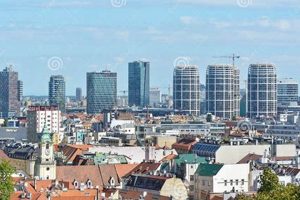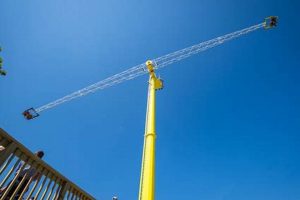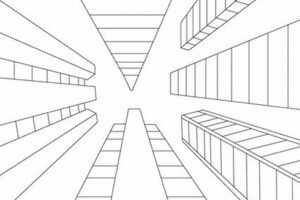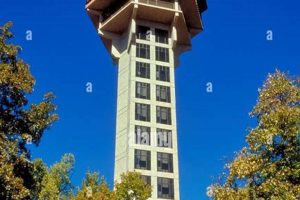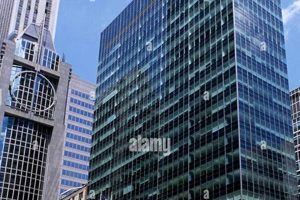A skyscraper, also known as a high-rise or a tower block, is a continuously habitable high-rise building with multiple floors. A skyscraper is a building that has over 40 floors and is taller than 150 meters (492 feet). It is designed for a variety of uses, including residential, commercial, and office space.
Skyscrapers are often constructed in densely populated urban areas where land is scarce and expensive. They offer a number of advantages over low-rise buildings, including increased energy efficiency, reduced land use, and improved views. Skyscrapers can also be iconic landmarks that define a city’s skyline.
The history of skyscrapers can be traced back to the late 19th century, when advances in construction technology and the invention of the elevator made it possible to build taller and taller buildings. The first skyscraper was the Home Insurance Building in Chicago, which was completed in 1885 and had 10 stories. Since then, skyscrapers have become increasingly common in cities around the world.
Today, skyscrapers are an essential part of many urban landscapes. They provide much-needed space for people to live and work, and they can also be a source of pride for a city.
1. Height
Height is a defining characteristic of skyscrapers, setting them apart from other types of buildings. This significant elevation not only contributes to their iconic status but also offers practical advantages and challenges in design and construction.
- Vertical Space Utilization: Skyscrapers maximize vertical space, allowing for a greater density of occupants and activities within a limited footprint. This efficient use of land is particularly valuable in densely populated urban areas where land is scarce and expensive.
- Panoramic Views: The height of skyscrapers offers breathtaking panoramic views of the surrounding cityscape and natural landscapes. Upper floors provide unparalleled vistas, making them highly desirable for residential, commercial, and hospitality purposes.
- Architectural Prowess: Constructing skyscrapers requires advanced engineering and architectural expertise to ensure structural stability and withstand various environmental forces, including wind, seismic activity, and extreme weather conditions.
- Engineering Challenges: The extreme height of skyscrapers presents challenges in elevator design, fire safety systems, and building maintenance. Specialized equipment and innovative solutions are necessary to address these challenges effectively.
In conclusion, the height of skyscrapers is not merely a defining feature but also a testament to human ingenuity and the pursuit of vertical living. Their towering presence reshapes urban skylines, offers unique experiences, and pushes the boundaries of architectural and engineering capabilities.
2. Purpose
Skyscrapers serve a diverse range of purposes, primarily encompassing residential, commercial, and office space. This versatility contributes significantly to their functionality and value in urban environments.
- Residential: Skyscrapers provide high-density housing options in urban areas, offering panoramic views and convenient access to amenities. They cater to a range of lifestyles, from luxury apartments to affordable housing units.
- Commercial: Skyscrapers house a variety of businesses, including retail stores, restaurants, entertainment venues, and fitness centers. They create vibrant commercial hubs that attract customers and contribute to the economic vitality of cities.
- Office space: Skyscrapers accommodate a multitude of offices for corporations, government agencies, and non-profit organizations. They offer modern work environments with efficient layouts, advanced technology, and stunning views.
The mixed-use nature of skyscrapers optimizes space utilization, promotes walkability, and reduces reliance on transportation. They foster a sense of community and convenience by integrating various functions within a single structure. Moreover, skyscrapers serve as landmarks that define a city’s skyline and contribute to its overall identity.
3. Location
The location of skyscrapers in densely populated urban areas is a defining characteristic that shapes their design, functionality, and impact on the surrounding environment.
Densely populated urban areas provide the necessary conditions for skyscrapers to thrive. High land prices and limited space drive the need for vertical development, making skyscrapers an efficient solution for maximizing space utilization. Urban areas also offer a concentration of businesses, residents, and amenities, creating a demand for high-rise structures that can accommodate a variety of functions.
Skyscrapers, in turn, contribute significantly to the vitality of urban areas. They provide much-needed housing, office space, and commercial opportunities, supporting economic growth and job creation. Skyscrapers also enhance the urban landscape, becoming iconic landmarks that define a city’s skyline and attract tourism. Additionally, they promote sustainability by reducing urban sprawl and encouraging the use of public transportation.
The connection between skyscrapers and densely populated urban areas is mutually beneficial. Skyscrapers provide essential space and functionality for growing urban populations, while urban areas offer the economic and social conditions that make skyscrapers viable and desirable.
4. Construction
The construction of skyscrapers relies heavily on advanced construction technology and elevators, which are essential for achieving their exceptional height, functionality, and safety.
- Innovative Structural Systems:
Skyscrapers employ innovative structural systems, such as reinforced concrete, steel frames, and diagrid designs, to withstand the immense weight and lateral forces acting upon them. These systems ensure structural stability and integrity, allowing skyscrapers to reach towering heights.
- Specialized Building Materials:
Skyscrapers utilize specialized building materials, including high-strength concrete, lightweight steel alloys, and advanced glass facades. These materials contribute to the strength, durability, and energy efficiency of skyscrapers.
- Advanced Construction Techniques:
Skyscrapers are constructed using advanced construction techniques, such as prefabr
ication, modular construction, and top-down construction. These techniques improve efficiency, reduce construction time, and enhance safety on high-rise projects. - Elevators and Transportation Systems:
Elevators are crucial for the functionality of skyscrapers, enabling efficient vertical transportation of people and goods. Skyscrapers often employ multiple elevator systems, including high-speed elevators, double-decker elevators, and panoramic elevators, to meet the demands of high-density occupancy.
These advanced construction technologies and elevators are integral to the design and construction of skyscrapers, enabling them to achieve their remarkable height, functionality, and safety. They represent the cutting edge of architectural engineering and play a vital role in shaping the modern urban landscape.
5. Energy efficiency
Skyscrapers offer significant energy efficiency advantages compared to low-rise buildings, making them a more sustainable option in densely populated urban areas. Several factors contribute to this reduced energy consumption:
- Reduced Surface Area: Skyscrapers have a smaller surface area relative to their volume compared to low-rise buildings. This reduced surface area minimizes heat loss and gain through the building envelope, leading to lower energy consumption for heating and cooling.
- Efficient Lighting Systems: Skyscrapers often incorporate energy-efficient lighting systems, such as LED lighting and daylight harvesting, which reduce electricity consumption for lighting. Natural light is maximized through large windows and skylights, further reducing the need for artificial lighting.
- Advanced HVAC Systems: Skyscrapers utilize advanced HVAC (heating, ventilation, and air conditioning) systems that optimize energy efficiency. These systems employ variable air volume (VAV) technology, heat recovery systems, and efficient chillers to minimize energy consumption while maintaining comfortable indoor temperatures.
- Renewable Energy Sources: Some skyscrapers incorporate renewable energy sources, such as solar panels and wind turbines, to generate on-site electricity. This reduces reliance on fossil fuels and further enhances the building’s energy efficiency.
The energy efficiency of skyscrapers is not only beneficial for reducing operating costs but also contributes to environmental sustainability. By consuming less energy, skyscrapers reduce greenhouse gas emissions and promote a greener, more sustainable urban environment.
In conclusion, the energy efficiency of skyscrapers is a key component of their design, contributing to their sustainability and reduced environmental impact. This makes skyscrapers a more attractive option for urban development, particularly in densely populated areas where energy conservation is a priority.
6. Land use
In densely populated urban areas where land is scarce and expensive, skyscrapers offer an efficient solution to maximize space utilization. They allow for a greater concentration of people and activities within a limited footprint, reducing urban sprawl and preserving valuable land resources.
- Vertical Expansion: Skyscrapers extend vertically rather than horizontally, allowing for a more compact and efficient use of land compared to low-rise buildings. This vertical expansion enables the construction of high-density residential, commercial, and office spaces within a confined area.
- Mixed-Use Developments: Skyscrapers often incorporate a mix of uses, such as residential units, office spaces, retail stores, and public amenities, within a single structure. This mixed-use approach optimizes space utilization and creates vibrant, self-contained urban environments.
- Reduced Infrastructure Costs: By concentrating development vertically, skyscrapers reduce the need for extensive infrastructure, such as roads, utilities, and public transportation networks. This results in cost savings and improved resource allocation.
- Preservation of Green Spaces: The efficient use of land through skyscrapers helps preserve green spaces and parks within urban areas. By minimizing the footprint of buildings, more land can be dedicated to public recreation, environmental conservation, and improving the overall quality of life.
In conclusion, the efficient use of limited land space is a crucial aspect of skyscraper design and development. By maximizing vertical expansion, incorporating mixed-use concepts, reducing infrastructure costs, and preserving green spaces, skyscrapers contribute to the sustainability and livability of densely populated urban environments.
7. Views
The availability of panoramic views from the upper floors of skyscrapers is a defining characteristic that sets them apart from other types of buildings. These elevated vantage points offer unparalleled vistas of the surrounding cityscape, natural landscapes, and distant horizons.
The connection between panoramic views and skyscraper definition lies in the unique experience they provide. The ability to gaze out over a vast expanse from such a height creates a sense of awe and inspiration. It allows occupants to appreciate the scale and beauty of their surroundings, fostering a connection to the city and its environment.
Moreover, panoramic views have practical significance. In residential skyscrapers, upper-floor units with expansive windows command premium prices due to their desirability. The natural light and breathtaking views enhance the quality of life for residents, making them highly sought-after properties.
In conclusion, panoramic views from upper floors are an integral component of skyscraper definition. They not only contribute to the aesthetic appeal and prestige of these structures but also offer practical benefits that enhance the living experience and add value to skyscraper developments.
8. Landmark
Skyscrapers have become iconic structures that define a city’s skyline, leaving an indelible mark on the urban landscape. Their towering presence and unique architectural features make them instantly recognizable landmarks, symbolizing the city’s identity and aspirations.
The connection between skyscrapers and their status as landmarks is multifaceted. Firstly, their sheer height and scale set them apart from other buildings, creating a visually striking presence that dominates the skyline. This vertical dominance gives skyscrapers a commanding aura, making them focal points of the city’s architectural tapestry.
Secondly, the architectural design of skyscrapers often incorporates innovative and distinctive elements that contribute to their landmark status. These elements can include intricate facades, unique setbacks, or sculptural forms that create a visually appealing and memorable silhouette. By pushing the boundaries of architectural design, skyscrapers become i
cons that represent the city’s creativity and architectural prowess.
Moreover, skyscrapers often serve as symbols of a city’s economic and cultural achievements. By housing prestigious corporations, financial institutions, and cultural landmarks, skyscrapers become associated with the city’s economic power and cultural vibrancy. They embody the city’s ambition, progress, and global standing, making them landmarks that evoke a sense of pride and identity among residents and visitors alike.
The practical significance of understanding the connection between skyscrapers and their status as landmarks lies in recognizing their value as tourism destinations and economic drivers. Iconic skyscrapers attract visitors from around the world, eager to witness their architectural grandeur and enjoy the panoramic views they offer. This influx of tourism generates revenue and supports local businesses, contributing to the city’s economy.
In conclusion, the connection between “Landmark: Iconic structures that define a city’s skyline” and “skyscraper def” is deeply intertwined. Skyscrapers’ height, architectural distinctiveness, and symbolic significance elevate them beyond mere buildings, transforming them into landmarks that shape the identity of cities and contribute to their economic and cultural vitality.
9. History
The historical origins of skyscrapers, traced back to the late 19th century, play a pivotal role in understanding their evolution and defining characteristics. This historical context sheds light on the technological advancements, architectural innovations, and societal factors that shaped the development of skyscrapers and continue to influence their presence in modern cities.
- Technological Advancements: The late 19th century witnessed breakthroughs in engineering and construction techniques, such as the invention of the steel frame and the elevator, which enabled the construction of taller and more stable buildings. These technological advancements laid the foundation for the development of skyscrapers as we know them today.
- Architectural Innovations: Architects and engineers experimented with new design concepts and aesthetic styles to create visually striking and functional skyscrapers. The Chicago School of Architecture, for example, pioneered the development of high-rise buildings with steel frames and large windows, which became a defining feature of early skyscrapers.
- Urbanization and Economic Growth: The rapid urbanization and economic growth in major cities during the late 19th century created a demand for more efficient use of land and space. Skyscrapers offered a solution by allowing for a greater density of population and businesses within a limited footprint, contributing to the vertical expansion of cities.
- Symbolism and Prestige: Skyscrapers quickly became symbols of economic power and architectural prowess. The construction of iconic skyscrapers, such as the Empire State Building and the Chrysler Building in New York City, represented a city’s ambition and desire to stand out on the global stage.
Understanding the historical context of skyscrapers is essential for appreciating their significance in the urban landscape. The technological advancements, architectural innovations, and societal factors that shaped their development have left a lasting legacy on the design, construction, and perception of skyscrapers today.
Skyscraper FAQs
This section addresses common questions and misconceptions surrounding the definition and characteristics of skyscrapers.
Question 1: What is the defining height requirement for a building to be considered a skyscraper?
Skyscrapers are typically defined as buildings that exceed 150 meters (492 feet) in height, although this can vary slightly depending on the specific definition used.
Question 2: Are skyscrapers only used for residential purposes?
No, skyscrapers can be used for a variety of purposes, including residential, commercial, office space, and mixed-use developments that combine multiple functions.
Question 3: What is the main advantage of constructing skyscrapers in densely populated urban areas?
Skyscrapers offer efficient use of limited land space, allowing for a greater concentration of people and activities within a confined area.
Question 4: Do all skyscrapers have panoramic views?
While many skyscrapers offer panoramic views from upper floors due to their height, not all skyscrapers have this feature. The availability of views depends on factors such as the building’s location, orientation, and architectural design.
Question 5: Are skyscrapers a relatively recent architectural development?
No, the history of skyscrapers can be traced back to the late 19th century, with the invention of new construction techniques and architectural innovations.
Question 6: What is the significance of skyscrapers as landmarks?
Skyscrapers often become iconic landmarks that define a city’s skyline and symbolize its economic power and architectural prowess.
Summary: Skyscrapers are continuously habitable high-rise buildings that typically exceed 150 meters (492 feet) in height. They offer efficient use of land space and can serve various purposes, including residential, commercial, and office use. Skyscrapers often have panoramic views from upper floors and have played a significant role in urban development since their inception in the late 19th century. Understanding these key characteristics helps us appreciate the unique contributions of skyscrapers to the built environment and urban landscapes.
Skyscraper Design Considerations
Skyscraper design involves a complex interplay of architectural, engineering, and urban planning principles. Here are key considerations for creating functional, sustainable, and visually appealing skyscrapers:
Tip 1: Structural Stability and Safety
Skyscrapers must withstand various forces, including wind, seismic activity, and gravity. Structural engineers employ advanced systems, such as reinforced concrete, steel frames, and diagrid designs, to ensure stability and safety.
Tip 2: Energy Efficiency and Sustainability
Skyscrapers can significantly impact energy consumption. Designers incorporate energy-efficient lighting, HVAC systems, and renewable energy sources to reduce their environmental footprint and operating costs.
Tip 3: Efficient Land Use and Urban Integration
Skyscrapers optimize land use in densely populated areas. Mixed-use developments combine residential, commercial, and public spaces, promoting walkability and reducing urban sprawl.
Tip 4: Panoramic Views and Natural Light
Upper floors of skyscrapers offer stunning panoramic views. Architects design with large windows and skylights to maximize natural light, enhancing occupants’ well-being and reducing energy consumption.
Tip 5: Contextual Design and Aesthetic Appeal
Skyscrapers should complement their surroundings while making a bold architectural statement. Designers consider the building’s scale, form, and materials to create visually appealing structures that harmonize with the urban fabric.
Tip 6: Advanced Construction Techniques
Skyscraper construction requires innovative techniques, such as prefabrication, modular construction, and top-down construction. These methods improve efficien
cy, reduce construction time, and enhance safety on high-rise projects.
Tip 7: Transportation and Accessibility
Skyscrapers require efficient transportation systems to move occupants and visitors. Designers integrate elevators, escalators, and public transit connections to ensure seamless accessibility.
Tip 8: Future-Proofing and Adaptability
Skyscrapers should be designed to adapt to changing needs and technologies. Flexible floor plans, adaptable infrastructure, and sustainable systems ensure that these structures remain relevant and valuable in the long term.
These considerations guide architects, engineers, and urban planners in creating skyscrapers that are not just tall buildings but transformative urban landmarks that enhance the built environment and contribute to the vitality of cities.
Skyscraper Definition Conclusion
In conclusion, a skyscraper is a continuously habitable high-rise building that typically exceeds 150 meters (492 feet) in height. Skyscrapers are designed for various purposes, including residential, commercial, and office use, and are often constructed in densely populated urban areas to maximize space utilization.
The unique characteristics of skyscrapers, such as their height, mixed-use functionality, efficient land use, panoramic views, and iconic status, have made them integral to modern urban landscapes. They represent architectural ingenuity, engineering prowess, and the pursuit of vertical living.
As cities continue to grow and evolve, skyscrapers will undoubtedly play an even greater role in shaping urban environments. Their ability to accommodate large populations, promote sustainability, and serve as landmarks will be essential for creating vibrant and livable cities of the future.


